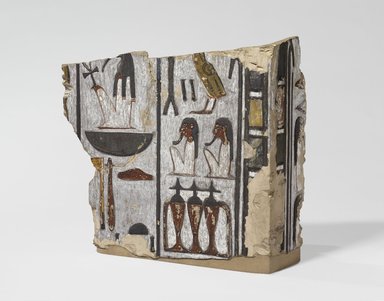
Medium: Limestone, pigment
Geograhical Locations:
Dates:ca. 1426–1190 B.C.E.
Dimensions: 15 x 12 3/4 x 4 3/4 in. (38.1 x 32.4 x 12.1 cm)
Collections:
Museum Location: 19th Dynasty to Roman Period, Martha A. and Robert S. Rubin Gallery, 3rd Floor
Exhibitions:
Accession Number: 37.1892E
Image: 37.1892E_PS9.jpg,
Catalogue Description: Limestone fragment of the corner of a tomb wall inscribed on two sides, which are perpendicular to each other, with hieroglyphs in raised relief. Seen from above the fragment is roughly a right-triangle in shape. The ground is painted a pale blue. The hieroglyphs are painted in the following manner: the hair of the seated men, the "neb" basket, the top of the vases, the "was" scepters, and the border lines are green; human skin, the "mdw" staff, the bottom vases and the outlines of the white garments of the seated figures are brown. The quail chick is yellow with brown outlines and green feet. The "ntr" sign is yellow with brown outlines and details. The border pattern is composed of yellow, green, red and blue (?) rectangles separated by small white rectangles. Condition: Large crack in paint in first column of text on side A; paint missing in spots on both sides A and B.